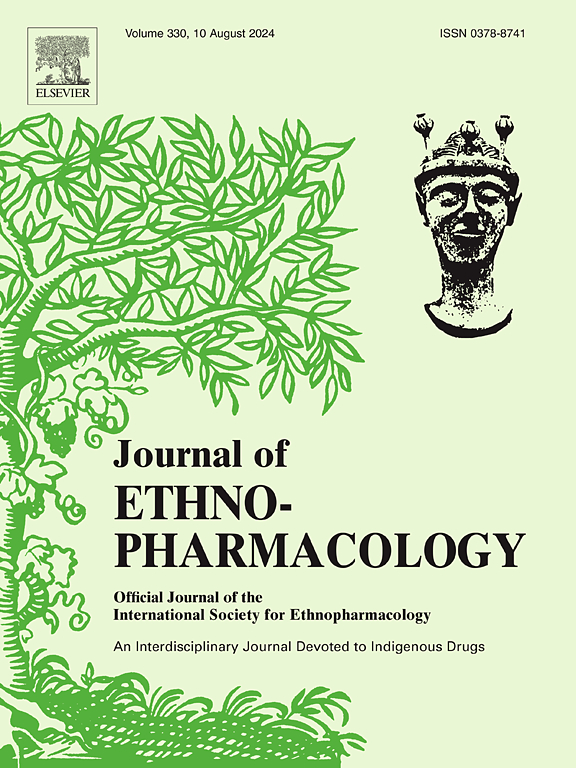再生臭Eisenia G90′-ES2蛋白复合物对辐射性皮肤损伤的治疗作用。
IF 5.4
2区 医学
Q1 CHEMISTRY, MEDICINAL
引用次数: 0
摘要
民族药理学相关性:辐射诱发皮肤损伤(RISI)是接受放射治疗的癌症患者遇到的主要皮肤副作用。在中国古代,地龙历来被用来治疗各种疾病。截断再生和高耐辐射是蚯蚓的两个显著特征。这些特征可能是由于其丰富的生物活性物质(65%由蛋白质组成),使其成为具有吸引力的放射性保护剂开发候选者。研究目的:本研究旨在通过蛋白质组学分析,探讨再生牛乳蛋白提取物(G90′-ES2)缓解RISI的作用机制,并揭示潜在的治疗大分子。材料与方法:首先采用蛋白盐沉淀法得到G90′-ES2/G90-ES2蛋白复合物。通过细胞活力、细胞迁移、活性氧积累、EdU增殖、细胞周期和细胞凋亡等实验评估其体外辐射防护活性。建立放射基因联合损伤小鼠模型,分析G90′-ES2在体内的放射治疗功能。通过RNA-Seq分析、qPCR和HIF荧光素酶报告基因分析证实了其抗RISI的机制。最后,采用纳米洗脱UPLC-MS/MS方法对G90′-ES2的潜在治疗大分子进行了分析。结果:我们发现G90'-ES2在缓解RISI方面表现出比G90-ES2更高的疗效,主要是通过激活放射耐药HIF-1通路,重新分配细胞周期阶段(s期保存),加速再上皮化,促进组织血管生成。G90′-ES2中显著上调的蛋白(包括蚓激酶、水通道蛋白、RAD51C、TCTP和SCBP2)可能对其治疗RISI的作用具有特别重要的意义。结论:本研究拓宽了我们对蚯蚓耐辐射和再生能力的认识;也为皮肤特异性放射防护剂的开发提供了医学候选材料。本文章由计算机程序翻译,如有差异,请以英文原文为准。

Therapeutic effects of G90′-ES2 protein complex from regenerated Eisenia fetida on radiation-induced skin injury
Ethnopharmacological relevance
Radiation-Induced Skin Injury (RISI) is the major cutaneous side effect met by cancer patients who received radiotherapy. Disposed earthworm (Dilong) has been historically employed for treating various ailments in ancient China. Amputated-regeneration and high radiation-tolerant are two distinctive characteristics for earthworms. These features might due to their abundant biologically active substances (65 % composed of proteins), which make them attractive candidates for radioprotector development.
Aim of the study
This study aimed to investigate therapeutic mechanism of regenerated E. fetida protein extract (G90′-ES2) in mitigating RISI, and reveal therapeutic potential macromolecules by proteomic analysis.
Materials and methods
Protein salt precipitation method was firstly adopted to obtain G90′-ES2/G90-ES2 protein complex. Their radioprotective activities were evaluated in vitro by cell viability, migration, ROS accumulation, EdU proliferation, cell cycle and apoptosis assays. A combined radiogenic injury mice model was constructed to analyze radiotherapeutic function of G90′-ES2 in vivo. Its mechanism against RISI was illustrated by RNA-Seq analysis, qPCR, and HIF Luciferase Reporter Assay. Finally, a nanoElute UPLC-MS/MS method was used to elucidate therapeutic potential macromolecules in G90′-ES2.
Results
We discovered that G90′-ES2 displayed higher efficacy than G90-ES2 in mitigating RISI, mainly by activating radio-resistant HIF-1 pathway, redistributing cell cycle phases (S-phase preservation), accelerating re-epithelialization, and enhancing tissue angiogenesis. The significantly up-regulated proteins (including lumbrokinase, aquaporin, RAD51C, TCTP, and SCBP2) in G90′-ES2 might hold particular importance for its therapeutic effect against RISI.
Conclusions
This investigation will broaden our understanding of the radiation-tolerant and regenerative capacities for earthworm; also provide medical candidates for the development of skin-specific radioprotector.
求助全文
通过发布文献求助,成功后即可免费获取论文全文。
去求助
来源期刊

Journal of ethnopharmacology
医学-全科医学与补充医学
CiteScore
10.30
自引率
5.60%
发文量
967
审稿时长
77 days
期刊介绍:
The Journal of Ethnopharmacology is dedicated to the exchange of information and understandings about people''s use of plants, fungi, animals, microorganisms and minerals and their biological and pharmacological effects based on the principles established through international conventions. Early people confronted with illness and disease, discovered a wealth of useful therapeutic agents in the plant and animal kingdoms. The empirical knowledge of these medicinal substances and their toxic potential was passed on by oral tradition and sometimes recorded in herbals and other texts on materia medica. Many valuable drugs of today (e.g., atropine, ephedrine, tubocurarine, digoxin, reserpine) came into use through the study of indigenous remedies. Chemists continue to use plant-derived drugs (e.g., morphine, taxol, physostigmine, quinidine, emetine) as prototypes in their attempts to develop more effective and less toxic medicinals.
 求助内容:
求助内容: 应助结果提醒方式:
应助结果提醒方式:


